Go early in the morning to a membership warehouse and watch the customer service center. A few people trickle in, and things are running smoothly. Everyone is getting help, and each person seems happy with the solution.
But then it picks up.
There’s a growing line.
You don’t see happy faces anymore, just frustrated, impatient smirks. And the employees? They look frazzled and keep glancing at the clock, hoping it’ll speed up for lunch break.
It’s the same uncomfortable experience for SaaS customers too when they’re left stranded needing help.
Inefficient customer support is good for no one.
Users don’t like it when they can’t get a timely answer. And employees don’t like it when they can’t keep up. Platforms can’t provide a positive customer experience if they can’t even fulfill users’ basic needs.
If you want to increase customer satisfaction, user retention, and user adoption while reducing churn, then it’s time to consider customer service automation.
I’m not talking about the faceless kind you get when you call a customer service phone line and talk in circles to a robot for 10 minutes.
It’s the kind of customer service automation that provides relevant and quick support so that your team can help with the complex cases—the kind of support where everyone wins. By reducing common support questions with AI help, you help free up your team and also make customers happy.
What does customer service automation mean for SaaS?
Customer service automation (CSA) is when SaaS companies invest in technology that automatically supports customers within the app.
Popular tools are chatbots, new feature tours, universal search, and more.
When companies improve their CSA, they can increase customer satisfaction, retention, and adoption. If platforms can decrease churn and make users happy through better customer support, they can improve and scale their apps.
Why does every SaaS business need customer service automation?
Have you ever bought something you didn’t know how to use?
Maybe you purchased a Mac after years of PC use, or you bought a manual car after driving automatic vehicles all your life. Whether an expert was next to you or not likely made all the difference.
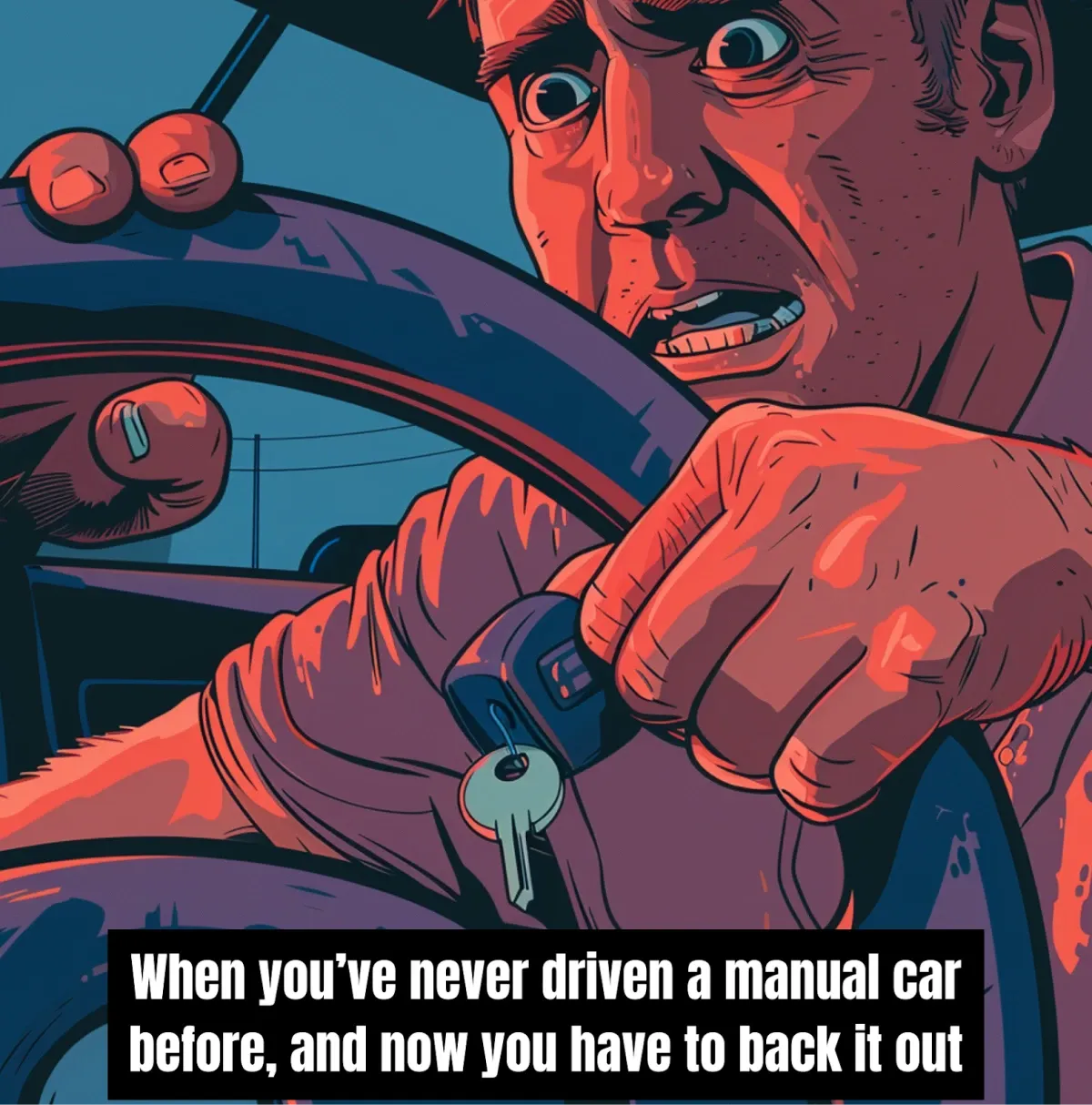
If you’re on your own in these types of situations, you might make frustrating mistakes. After spending hours trying to figure out how things work, you might curse under your breath and even think about returning the item or just giving up (and many do when left alone with no help).
But when someone is there to guide you, everything changes.
You get excited as you watch the guide passionately describe how fantastic the product is. When you learn how it works, you feel terrific and can’t wait to take full advantage of everything it can do.
It’s the same product. It’s a different experience.
If SaaS apps can work to make a user-friendly, intuitive app, they only need to implement an excellent customer service strategy. Unfortunately, if you want to scale, it can seem impossible to support so many users with humans alone.
More often than not, customers are left alone to try troubleshooting issues themselves. But SaaS has a secret weapon.
Companies can offer A+ support to users, just like that guy selling ice-cold lemonade on a hot day at the neighborhood baseball game—finally, something refreshing! Customer service automation leverages technology so customers get the support they need 24/7.
Customer service automation scales your customer support beyond the limitations of a human team. It’s difficult for users to get help on a personal level with the average B2B SaaS. When an app provides immediate support, a positive experience is just as refreshing as that cold glass of lemonade.
The typical traditional CSA vs. a new way
Go to a pizza place and ask for a list of toppings. You’ll get many options. As a customer, you love it because there’s always a solution for your cravings and needs.
Automation offers the same flexibility today, with many SaaS companies choosing various ways to streamline customer service. People learn in different ways, and they have unique needs. Companies can offer immediate help with the attention users deserve by providing customized journeys instead of forced experiences.
Popular customer service automation features include:
- Automatic support tickets: Customers who are frustrated or need help can explain the issue right in the app, and your team will be notified. Support reps can quickly respond through email or a call.
- AI chatbots: Users can click on an AI assistant and converse with the robot. The tool can answer questions, point users in the right direction, use DPO to meet customer inquiries, or connect customers to your team. Chatbots can also point users to a resource center.
- Canned messages and live chatting: Teams can run automated systems with a live chat box so that users can ask questions and get fast responses from humans. To automate the process, you can craft canned answers to common questions.
- Knowledge bases: Users can access a knowledge base for more information in-app to dig deeper or to find answers to technical questions.
- Popups and notifications: Automatic announcements can communicate important information to customers. The problem is that they are often annoying and distracting for users.
While most of these assets are helpful and add value to your customer service automation strategy, they aren’t the only thing apps can do. Left to run on their own, these features do very little for customer support and experiences if you aren’t providing the proper foundation in the first place.
SaaS companies can pause before thinking about speeding up and automating customer service. Instead, they should dive into the root reason for customer support in the first place.
Businesses can offer better support if they focus customer service automation and artificial intelligence on user assistance throughout the app experience.
In-app assistance is the first line of defense to filter out questions from customers that can be answered in-product. This strategy is more efficient and faster than human support, and it relies solely on automation while adding value to the experience.
When customers need help after going through personalized support automation, your human support agents can spend more time on tricky cases.
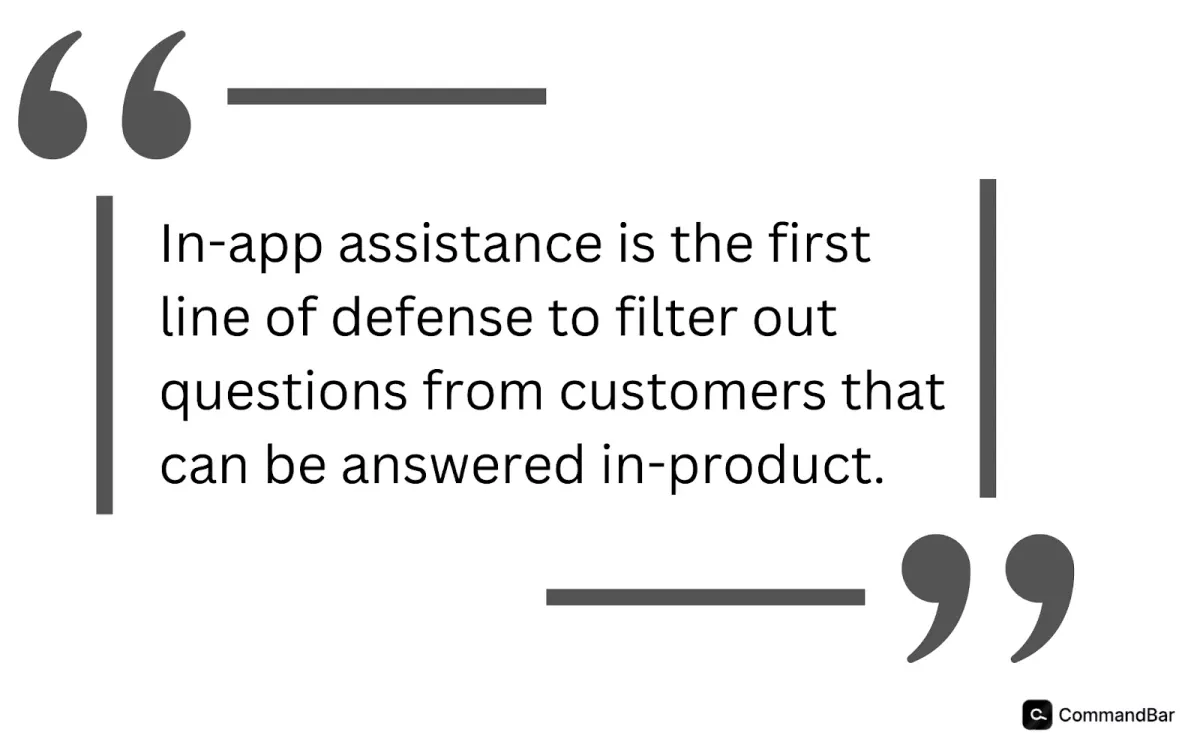
Say that again? Clarifying the ultimate goal
Customer automation support should do two things:
- Provide fast, better support to customers
- Eliminate the burden from your human support team
If you can implement an automation strategy that achieves both goals, you can provide a better platform experience and leverage your team where needed.
And it’s not just automation alone.
It’s intertwining a holistic experience throughout the app for every user type. You can increase customer satisfaction in multiple ways by gaining information and providing help.
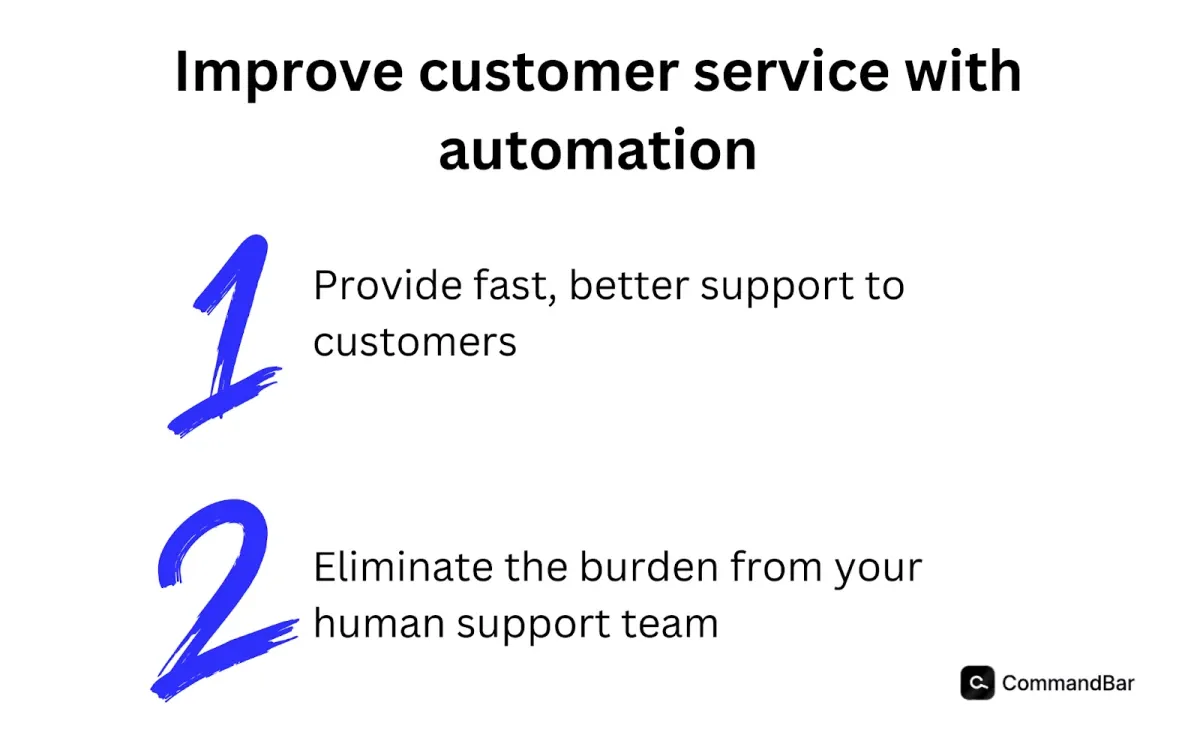
Additionally, automation and human service open room for optimizing for customer interactions through in-app messaging and customer feedback.
Simon Bacher, CEO of Ling, the app that helps teams learn new languages, states: “An often underestimated strategy … is maintaining an ongoing, open dialogue with customers. Feedback isn’t just for troubleshooting; it’s a gold mine of insights that can guide product development, improve on customer service costs, and ultimately foster customer loyalty.”
By listening to customers and gathering data to understand them better, we can improve our AI support tools and overall product experience.
One way to do this is by finding deadends in a universal search.
The automation search feature allows users to find resources and documentation for more information about your app. If they search for something that doesn’t exist and instead find a deadend or a half-answer to their question, you can note it. Use the deadend to inform app improvements (while providing a new resource to solve that inquiry).
Additionally, companies can initiate automatic microsurveys to gather insightful feedback. Businesses can also make in-app communication easy to gather important customer queries so teams can use them to improve the experience.
SaaS companies can mine customer data to begin segmenting audiences to craft better, targeted customer experiences.
Long-term, big-picture gains from embracing automation
Does automation improve customer service? Not on its own. Excellent automated customer service, without the proper context, falls flat.
Imagine going to a spa to celebrate a big birthday. The fancy staff presents an artisan comb to each customer, personalized with the person’s name. They give you yours—but you’re bald and have no beard. That backfired. What seemed to be excellent customer service on the part of the spa revealed a false sense of understanding the details and needs of individual customers.
Customer service automation tools should work hand in hand with your personalized customer service agents and journey experience.
For example, when new users log in to your app for the first time, they should see an onboarding survey.
New customers communicate how they are interested in your app. Using that information, your platform sends them a personalized checklist product tour that leads to their desired use case. Users get exactly what they want in seconds and reach the aha moment, or the fast time-to-value experience during customer activation.
The best customer service is a positive first impression. Once you nail it down, you continue to provide in-app guidance through nudges, which gently point users in the right direction instead of annoying popups jumping in their face like a Halloween prank. Customers also experience AI chat assistance, a resource hub, tooltips, feature checklists, and more for the ultimate user experience.
If customers need help, they send a message to the AI assistant. If the question is too complex, the assistant can point users to the right person instead of giving an unhelpful canned response. The SaaS can analyze the AI assistants to discover natural in-app feedback as well.
Intuitive, personal, and helpful experiences completely transform the customer experience.
It’s really that simple.
Build an app with customer segments and personalized journeys in mind. That takes care of half the issues. In-app customer service automation can then help users when they need assistance. If they need more help, they can contact your team, which now has more time and resources to handle complex issues with high-quality customer service reps.
With that said, we can look at the following pillars of CSA and how it will shape our future:
- CSA is the path to feature adoption. When you provide 24/7 personal support through AI, users have a better app experience and are more likely to use your app for the long term.
- Customer service automation gives your team a capacity boost. Now, your team has the energy to provide better and more in-depth customer service. With an optimized customer service team focused on high-output tasks, you can increase customer satisfaction and retention.
- Automation improves personalization and user satisfaction. You can provide better customized journeys so that users get what they need, when they need it. This can increase productivity adoption and create loyal customers with a higher customer lifetime value.
Imagining the perfect customer service experience
You will never forget the first time you walked into a business that offered the best customer service experience of your life. Maybe it was at a hotel where the staff greeted you by name. They had your room ready when you arrived, and a bottle of chilled champagne with glasses awaited you. Throughout the week, they exceeded your expectations and surprised you with something new each day.
SaaS companies can do that—and they don’t need to wear a fancy bow tie or offer their users extravagant experiences. It doesn’t have to be anything like that.
By creating an unbeatable, personal customer journey and following your users along the way, you can inform and strategize your customer service AI tools to support your user base.
Part of creating a great experience is empowering customers. Your own customer service tools and automation features can fuel self-guided experiences. You follow users’ curiosities and guide them, not force them, as they adopt your features and product.
When customers go through a feature checklist, they don’t have to go through each step. They can skip the ones they are uninterested in. They don’t have to read a step if they don’t want to. Instead, they can watch a video or try the steps first to experience the app quickly. This diverse educational and support experience serves many kinds of users and creates the personalized experience all customers want.
If you solve deadends, frustrations, and unnecessary learning curves, you are consistently improving your platform and, over time, creating a perfect experience.
Through a proactive customer service go-first approach, we can automate customer service and evolve our apps to become the unique solution for each user.
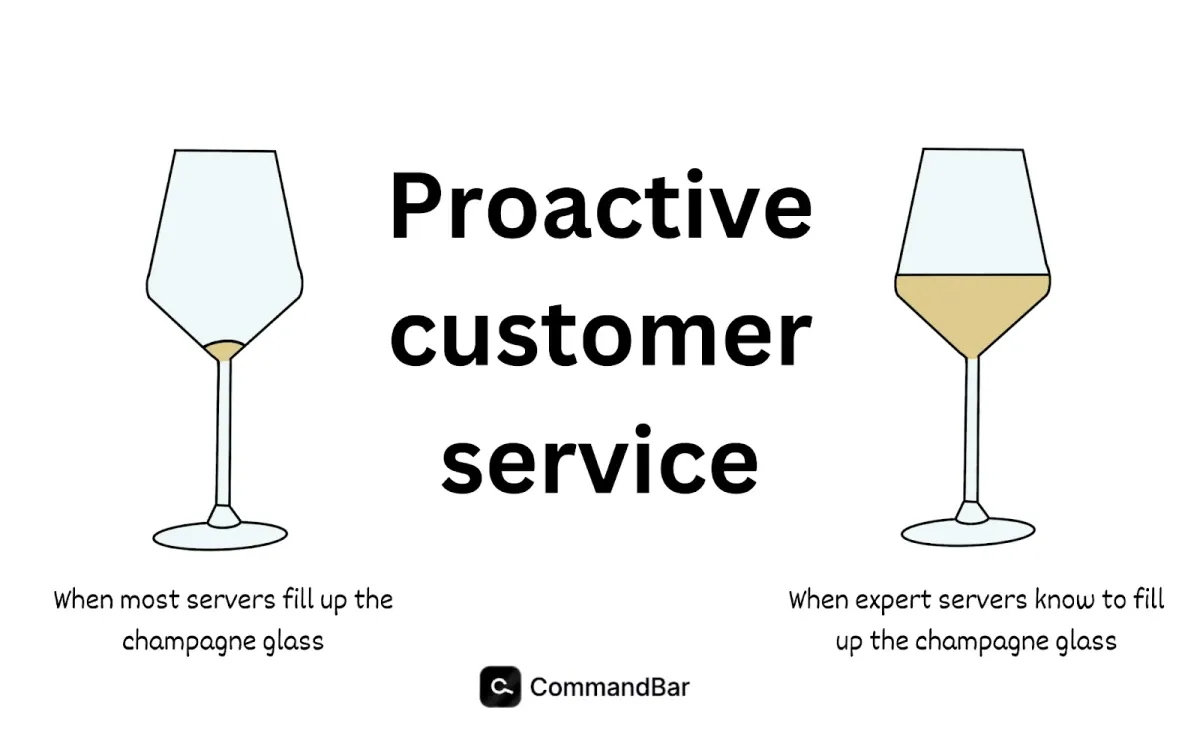
Where to start with support automation: Strategic considerations
I’m gonna clarify what I’ve been saying for those in the back: customer service is your most impactful marketing and growth strategy.
Build an experience with a user-first strategy, and customers will have a positive experience. Offer the support features when they need extra help, and you will retain your customers. Learn from your users, and you will create loyal users and brand advocates.
While most of us can agree on these core principles, it’s easier said than done.
We need a solution combining CSA features while providing the data and tools we need for a holistic, rounded customer service action plan.
Expand your self-service and support capacity with a customer service automation platform
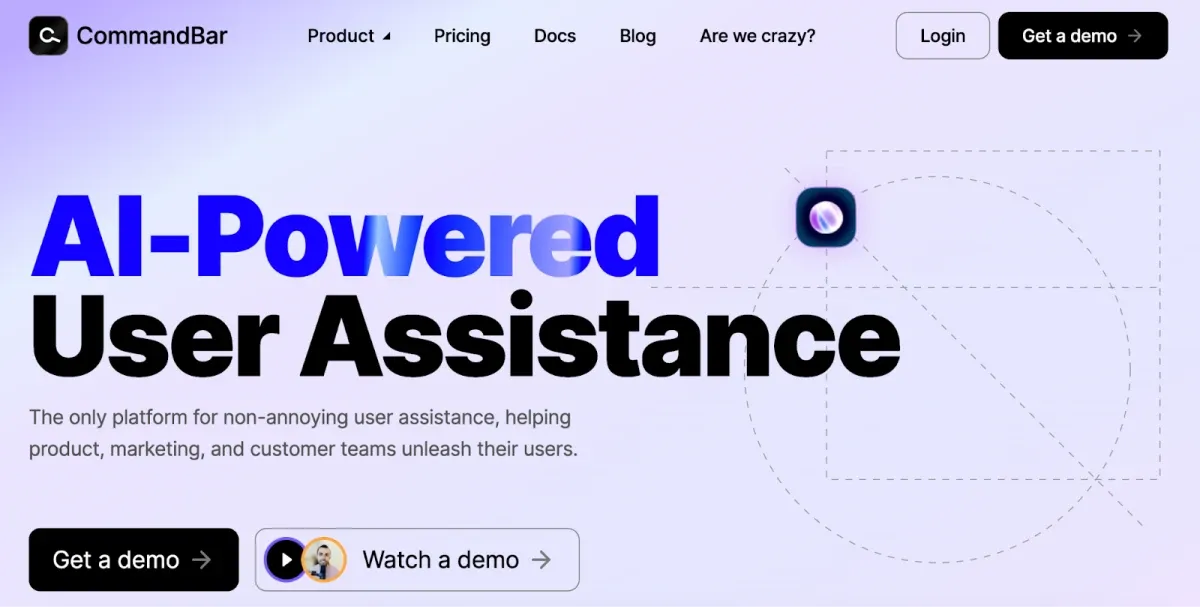
Customer service automation tools should have the features necessary to collect information, deploy support features, and empower both users and your team to communicate with each other.
Here’s a better way to look at it: B2B SaaS needs a customer support reduction tool.
If your platform can support customers immediately and filter out common issues so that your team can focus on unique cases, you can provide a better overall experience.
For example, an AI-powered user assistance platform like Command AI can address common queries and guide users before they need support. It reduces support workload and positions proactive in-app user guidance, customer understanding, and support.
All-in-one user support platforms automate your customer experience by offering 24/7 service to users and taking the burden away from your team. You can now scale your app without sacrificing the quality of your user experience. When you start winning at customer support, you start growing in all the right metrics.

















